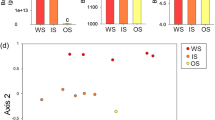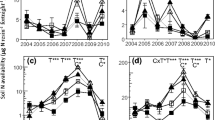Abstract
Soils are important sources and sinks of three greenhouse gases (GHGs): carbon dioxide (CO2), methane (CH4), and nitrous oxide (N2O). However, it is unknown whether semiarid landscapes are important contributors to global fluxes of these gases, partly because our mechanistic understanding of soil GHG fluxes is largely derived from more humid ecosystems. We designed this study with the objective of identifying the important soil physical and biogeochemical controls on soil GHG fluxes in semiarid soils by observing seasonal changes in soil GHG fluxes across a three million year substrate age gradient in northern Arizona. We also manipulated soil nitrogen (N) and phosphorus availability with 7 years of fertilization and used regression tree analysis to identify drivers of unfertilized and fertilized soil GHG fluxes. Similar to humid ecosystems, soil N2O flux was correlated with changes in N and water availability and soil CO2 efflux was correlated with changes in water availability and temperature. Soil CH4 uptake was greatest in relatively colder and wetter soils. While fertilization had few direct effects on soil CH4 flux, soil nitrate was an important predictor of soil CH4 uptake in unfertilized soils and soil ammonium was an important predictor of soil CH4 uptake in fertilized soil. Like in humid ecosystems, N gas loss via nitrification or denitrification appears to increase with increases in N and water availability during ecosystem development. Our results suggest that, with some exceptions, the drivers of soil GHG fluxes in semiarid ecosystems are often similar to those observed in more humid ecosystems.




Similar content being viewed by others
References
Aronson EL, Allison SD (2012) Meta-Analysis of environmental impacts on nitrous oxide release in response to N amendment. Front Microb 3:272
Aronson EL, Helliker BR (2010) Methane flux in non-wetland soils in response to nitrogen addition: a meta-analysis. Ecology 91:3242–3251
Austin AT (2011) Has water limited our imagination for aridland biogeochemistry? Trends Ecol Evol 26(5):229–235
Austin AT, Yahdjian L, Stark JM, Belnap J, Porporato A, Norton U, Ravetta DA, Schaeffer SM (2004) Water pulses and biogeochemical cycles in arid and semiarid ecosystems. Oecologia 141(2):221–235
Bremner JM (1997) Sources of nitrous oxide in soils. Nutr Cycling Agroecosyst 49:7–16
Chapuis-Lardy L, Wrage N, Metay A, Chotte J, Bernoux M (2007) Soils, a sink for N2O? A review. Glob Change Biol 13:1–17
Ciais P, Sabine C, Bala G, Bopp L, Brovkin V, Canadell J, Chhabra A, DeFries R, Galloway J, Heimann M, Jones C, Le Quéré C, Myneni RB, Piao S, Thornton P (2013) Carbon and other biogeochemical cycles. In: Stocker TF, Qin D, Plattner GK, Tignor M, Allen SK, Boschung J, Nauels A, Xia Y, Bex V, Midgley PM (eds) Climate Change 2013: The Physical Science Basis. Contribution of Working Group 1 to the Fifth Assessment Report of the Intergovernmental Panel on Climate Change. Cambridge University Press, New York
Cleveland CC, Townsend AR (2006) Nitrogen and phosphorus additions cause substantial losses of soil carbon from a lowland tropical rain forest. Proc Natl Acad Sci USA 103:10316–10321
Crutzen PT (1974) Estimates of possible variations in total ozone due to natural causes and human activities. Ambio 3(6):201–210
Davidson EA, Seitzinger S (2006) The enigma of progress in denitrification research. Ecol Appl 16:2057–2063
Davidson EA, Swank WT, Perry TO (1986) Distinguishing between nitrification and denitrification as sources of gaseous nitrogen production in soil. Appl Environ Microbiol 52(6):1280–1286
De’ath G, Fabricius KE (2000) Classification and regression trees: A powerful yet simple technique for ecological data analysis. Ecology 81:3178–3192
Del Grosso SJ, Parton WJ, Mosier AR, Ojima DS, Potter CS, Borken W, Brumme R, Butterbach-Bahl K, Crill PM, Dobbie K, Smith KA (2000) General CH4 oxidation model and comparisons of CH4 oxidation in natural and managed systems. Global Biogeochem Cy 14(4):999–1019
Dutaur L, Verchot L (2007) A global inventory of the soil CH4 sink. Global Biogeochem Cy 21:GB4013
Elser JJ, Bracken MES, Cleland EE, Gruner DS, Harpole WS, Hillebrand H, Ngai JT, Seabloom EW, Shurin JB, Smith JE (2007) Global analysis of nitrogen and phosphorus limitation of primary producers in freshwater, marine and terrestrial ecosystems. Ecol Lett 10:1135–1142
Galbally I, Meyer CP, Wang Y-P, Kirstine W (2010) Soil-atmosphere exchange of CH4, CO, N2O, and NOx and the effects of land-use change in the semiarid Mallee system in Southeastern Australia. Glob Chang Biol 16:2407–2419
Hashimoto S, Carvalhais N, Ito A, Migliavacca M, Nishina K, Reichstein M (2015) Global spatiotemporal distribution of soil respiration modeled using a global database. Biogeosciences Discuss 12:4331–4364
Hobbie S, Vitousek P (2000) Nutrient limitation of decomposition in Hawaiian forests. Ecology 81(7):1867–1877
Houghton JT, Meira Filho LG, Callander BA, Harris N, Kattenberg A, Maskell K (1996) Climate change 1995: The science of climate change. Cambridge University Press, Cambridge
Jenny H (1941) Factors of soil formation. McGraw-Hill, New York
Johnson EA, Miyanishi K (2008) Testing the assumptions of chronosequences in succession. Ecol Lett 11:419–431
Lal R (2004) Carbon sequestration in dryland ecosystems. Environ Manage 33(4):528–544
Le Mer J, Roger P (2001) Production, oxidation, emission and consumption of methane by soils: a review. Eur J Soil Biol 37:25–50
Looney CE, Sullivan BW, Kolb TE, Kane JM, Hart SC (2012) Pinyon pine (Pinus edulis) mortality and response to water addition across a three million year substrate age gradient in northern Arizona, USA. Plant Soil 357:89–102
Mahecha MD, Reichstein M, Carvalhais N, Lasslop G, Lange H, Seneviratne SI, Vargas R, Ammann C, Arain MA, Cescatti A, Janssens IA, Migliavacca M, Montagnani L, Richardson AD (2010) Global convergence in the temperature sensitivity of respiration at ecosystem level. Science 329:838–840
Martin LJ, Blossey B, Ellis E (2012) Mapping where ecologists work: biases in the global distribution of terrestrial ecological observations. Front Ecol Environ 10(4):195–201
Martinelli LA, Piccolo MC, Townsend AR, Vitousek PM, Cuevas E, McDowell W, Robertson GP, Santos OC, Treseder K (1999) Nitrogen stable isotopic composition of leaves and soil: tropical versus temperate forests. Biogeochemistry 46:45–65
Montzka SA, Dlugokencky EJ, Butler JH (2011) Non-CO2 greenhouse gases and climate change. Nature 476:43–50
Moore RB, Wolfe EW (1987) Geologic map of the east part of the San Francisco Volcanic Field, north-central Arizona, scale 1:50,000. Misc Field Stud Map MF-1960 US Geol Surv, Washington, DC
Neff JC, Bowman WD, Holland EA, Fisk MC, Schmidt SK (1994) Fluxes of nitrous oxide and methane from nitrogen-amended soils in a Colorado alpine ecosystem. Biogeochemistry 27(1):23–33
Neff JC, Townsend AR, Gleixner G, Lehman SJ, Turnbull J, Bowman WD (2002) Variable effects of nitrogen additions on the stability and turnover of soil carbon. Nature 419:915–917
Newman GS, Hart SC (2015) Shifting soil resource limitations and ecosystem retrogression across a three million year semi-arid substrate age gradient. Biogeochemistry 124(1–3):177–186
Nömmik H (1956) Investigations on denitrification in soil. Acta Agr Scand 6(2):195–228
Orchard VA, Cook FJ (1983) Relationship between soil respiration and soil moisture. Soil Biol Biochem 15(4):447–453
Parker SS, Schimel JP (2011) Soil nitrogen availability and transformations differ between the summer and the growing season in a California grassland. Appl Soil Ecol 48:185–192
Parton W, Silver WL, Burke IC, Grassens L, Harmon ME, Currie WS, King JY, Adair EC, Brandt LA, Hart SC, Fasth B (2007) Global-scale similarities in nitrogen release patterns during long-term decomposition. Science 315(5810):361–364
Peltzer DA, Wardle DA, Allison VJ, Baisden WT, Bardgett RD, Chadwick OA, Condron LM, Parfitt RL, Porder S, Richardson SJ, Turner BL, Vitousek PM, Walker J, Walker LR (2010) Understanding ecosystem retrogression. Ecol Monogr 80:509–529
Potter CS, Davidson EA, Verchot LV (1996) Estimation of global biogeochemical controls and seasonality in soil methane consumption. Chemosphere 32(11):2219–2246
Priest SS, Duffielt WA, Malis-Clark K, Hendley II JW, Stauffer PH (2001) The San Francisco Volcanic Field, Arizona. Fact Sheet 017-01. US Geol Surv, Washington D.C
R Core Team (2014) R: A language and environment for statistical computing. R Foundation for Statistical Computing, Vienna URL: http://www.R-project.org/
Raich JW, Schlesinger WH (1992) The global carbon dioxide flux in soil respiration and its relationship to vegetation and climate. Tellus B 44:81–99
Reynolds JF (2001) Desertification. In: Levin SA (ed) Encyclopedia of Biodiversity. Academic Press, San Diego
Running SW, Nemani RR, Heinsch FA, Zhao M, Reeves M, Hashimoto H (2004) A continuous satellite-derived measure of global terrestrial primary production. Bioscience 54(6):547–560
Safriel U, Adeel Z (2008) Development paths of drylands: thresholds and sustainability. Sustain Sci 3:117–123
Segers R (1998) Methane production and methane consumption: a review of processes underlying wetland methane fluxes. Biogeochem 41:23–51
Selmants PC (2007) Carbon, Nitrogen, and phosphorus dynamics across a three million year substrate age gradient in northern Arizona, USA. Ph.D. Thesis, Northern Arizona University
Selmants PC, Hart SC (2008) Substrate age and tree islands influence carbon and nitrogen dynamics across a retrogressive semiarid chronosequence. Glob Biogeochem Cycles 22:GB1021
Selmants PC, Hart SC (2010) Phosphorus and soil development: does the Walker and Syers model apply to semiarid ecosystems? Ecology 91(2):474–484
Sheppard PR, Comrie AC, Packin GD, Angersbach K, Hughes MK (2002) The climate of the US southwest. Clim Res 21(3):219–238
Shine KP, Sturges WT (2007) CO2 is not the only gas. Science 315:1804–1805
Stark JM, Firestone M (1995) Mechanims for soil moisture effects on nitrifying bacteria. Appl Environ Microb 61(1):218–221
Striegl RG (1993) Diffusional limits to the consumption of atmospheric methane by soils. Chemosphere 26:715–720
Striegl RG, McConnaughey TA, Thorstenson DC, Weeks EP, Woodward JC (1992) Consumption of atmospheric methane by desert soils. Nature 357:145–147
Sullivan BW, Kolb TE, Hart SC, Kaye JP, Hungate BA, Dore S, Montes-Helu M (2011) Wildfire reduces carbon dioxide efflux and increases methane uptake in ponderosa pine forest soils of the southwestern USA. Biogeochemistry 104:251–265
Sullivan BW, Selmants PC, Hart SC (2012) New evidence that high potential nitrification rates occur in soils during dry seasons: are microbial communities metabolically active during dry seasons? Soil Biol Biochem 53:28–31
Sullivan BW, Selmants PC, Hart SC (2013) Does dissolved organic carbon regulate biological methane oxidation in semiarid soils? Glob Change Biol 19(7):2149–2157
Sullivan BW, Alvarez-Clare S, Castle SC, Porder S, Reed SC, Schreeg L, Townsend AR, Cleveland CC (2014) Assessing nutrient limitation in complex forested ecosystems: alternatives to large-scale fertilization experiments. Ecology 95(3):668–681
Tanaka K, Shoemaker EM, Ulrich GE, Wolfe TW (1986) Migration of volcanism in the San Francisco Volcanic Field, Arizona. Geol Soc Am Bull 97:129–141
Therneau T, Atkinson B (2014) An introduction to recursive partitioning using the RPART Routines. http://cran.r-project.org/web/packages/rpart/vignettes/longintro.pdf 62 pp
Vitousek PM (2002) Oceanic islands as model systems for ecological studies. J Biogeogr 29:573–582
Vitousek PM (2004) Nutrient cycling and limitation: Hawai’i as a model system. Princeton University Press, NJ
Vitousek PM, Farrington H (1997) Nutrient limitation and soil development: experimental test of a biogeochemical theory. Biogeochemistry 37:63–75
Vitousek PM, Howarth RW (1991) Nitrogen limitation on land and in the sea: How can it occur? Biogeochemistry 13:87–115
Walker TW, Syers JK (1976) The fate of phosphorus during pedogenesis. Geoderma 15:1–19
Walker LR, Wardle DA, Bardgett RD, Clarkson BD (2010) The use of chronosequences in studies of ecological succession and soil development. J Ecol 98:725–736
Wardle DA, Walker LR, Bardgett RD (2004) Ecosystem properties and forest decline in contrasting long-term chronosequences. Science 305:509–513
Webster EA, Hopkins DW (1996) Contributions from different microbial processes to N2O emission from soil under different moisture regimes. Biol Fertil Soils 22:331–335
Acknowledgments
This research was supported by a Hooper Undergraduate Research Award and funding from the Ecological Restoration Institute at NAU to M.K.N., a Mission Research Program grant to B.W.S. and S.C.H., and an NSF IGERT fellowship to B.W.S. We thank S.R. Jackson for her assistance in the lab and field, and S. Alvarez Clare and several anonymous reviewers for helpful comments on this manuscript. We especially appreciate the efforts of G.S. Newman and K.L. Hess in establishing the fertilization plots across the SAGA.
Author information
Authors and Affiliations
Corresponding author
Additional information
Responsible Editor: Marc Kramer.
Rights and permissions
About this article
Cite this article
Sullivan, B.W., Nasto, M.K., Hart, S.C. et al. Proximate controls on semiarid soil greenhouse gas fluxes across 3 million years of soil development. Biogeochemistry 125, 375–391 (2015). https://doi.org/10.1007/s10533-015-0133-0
Received:
Accepted:
Published:
Issue Date:
DOI: https://doi.org/10.1007/s10533-015-0133-0




